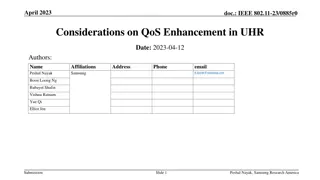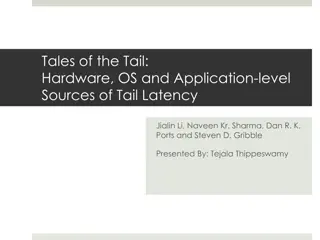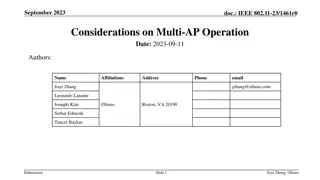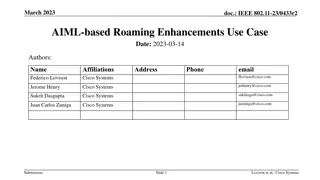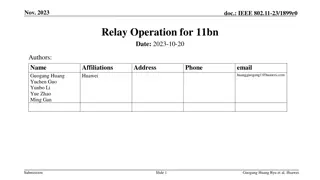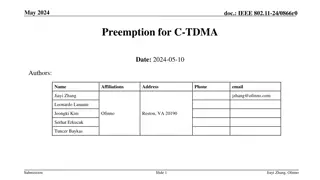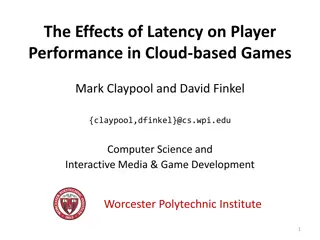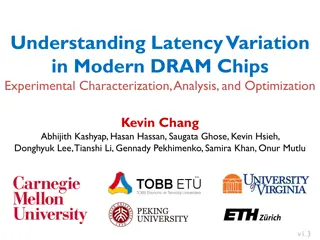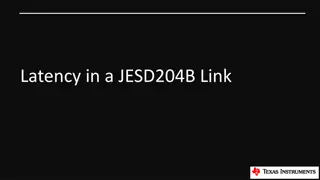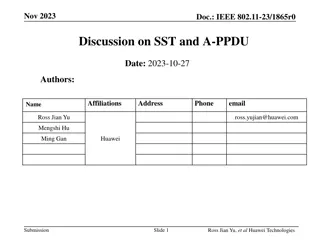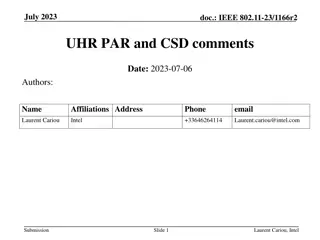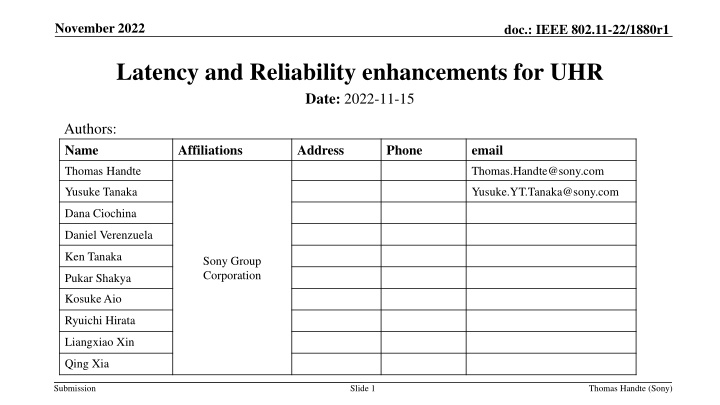
Enhancements for Ultra-High-Reliability Networks: Trends and Solutions
Explore the latest advancements in low-latency and high-reliability technologies for Ultra-High-Reliability (UHR) networks, focusing on event-based data transfer, smart manufacturing, and the transition to Spiking Neural Networks (SNN). Discover key technical trends, such as event-based vision sensors and neuromorphic computing, and learn about performance gains through simulation studies. Find out how UHR can support non-static, event-driven traffic and address challenges in delivering low-latency data effectively.
Download Presentation

Please find below an Image/Link to download the presentation.
The content on the website is provided AS IS for your information and personal use only. It may not be sold, licensed, or shared on other websites without obtaining consent from the author. If you encounter any issues during the download, it is possible that the publisher has removed the file from their server.
You are allowed to download the files provided on this website for personal or commercial use, subject to the condition that they are used lawfully. All files are the property of their respective owners.
The content on the website is provided AS IS for your information and personal use only. It may not be sold, licensed, or shared on other websites without obtaining consent from the author.
E N D
Presentation Transcript
November 2022 doc.: IEEE 802.11-22/1880r1 Latency and Reliability enhancements for UHR Date: 2022-11-15 Authors: Name Affiliations Address Phone email Thomas Handte Thomas.Handte@sony.com Yusuke Tanaka Yusuke.YT.Tanaka@sony.com Dana Ciochina Daniel Verenzuela Ken Tanaka Sony Group Corporation Pukar Shakya Kosuke Aio Ryuichi Hirata Liangxiao Xin Qing Xia Submission Slide 1 Thomas Handte (Sony)
November 2022 doc.: IEEE 802.11-22/1880r1 Introduction The UHR study group was formed to investigate technologies to improve reliability, latency, manageability, throughput and power consumption [1] Various technologies have been suggested for consideration in UHR such as Multi-AP [2-5] Preemption [6] mmWave MLO [7-8] MIMO enhancements [9] Power save [10-11] In this presentation, we highlight Technological trends with low-latency and reliability requirement Technical solutions to address those trends and which improve performance of UHR beyond EHT Low-latency EDCA Preemption Soft combination (HARQ) Performance gains obtained by initial simulation studies Submission Slide 2 Thomas Handte (Sony)
November 2022 doc.: IEEE 802.11-22/1880r1 Technical Trends Demand for event-based low-latency data transfer Content rendering corresponding to the user s input/motion (e.g. VR, gaming) Event-based vision sensors (e.g. neuromorphic camera) Image sensors with varying data rate depending on perceived scene Sparse time-critical events (e.g. limit switch, emergency stop) Neuromorphic computing Transition from DNN to SNN Low-latency traffic is event-driven and non-static in such applications Demand for high reliability Smart manufacturing (industry 4.0) asks for high(er) reliability E.g. robotics and M2M communications Demand for high reliability goes hand in hand with low-latency requirements A timely delivered data unit has little value if erroneous High reliability may translate into long range communication with lower reliability High reliability is more important as throughput improvement for such applications Submission Slide 3 Thomas Handte (Sony)
November 2022 doc.: IEEE 802.11-22/1880r1 Improving low-latency EHT provides some improvements for low-latency data delivery MLO increases likelihood of channel access EHT SCS can be used to provision low-latency traffic (R-)TWT may provide additional priority to low-latency traffic These mechanisms require that low-latency traffic has predictable and (quasi-)static characteristics UHR should support event-driven (i.e. non-predictable) low-latency traffic Using EHT is not good solution, because mapping of event-driven traffic to static schedules may cause Additional queuing delay Packet loss due to expired MSDU lifetime Waste of resources if there is nothing to transmit Currently, low-latency traffic cannot be sent once a device is occupied by communication that it has already started Submission Slide 4 Thomas Handte (Sony)
November 2022 doc.: IEEE 802.11-22/1880r1 How to improve latency for event-based traffic? (Re)considering EDCA instead of triggered access Need EDCA variant of EHT SCS [12] Need to seek improvement for EDCA to make it more suitable for low-latency [13-15] Cooperation among STAs of a BSS Channel access on secondary channels Preemption Suspend low-priority traffic in favor of low-latency packets [6] Different levels of preemption can be envisioned Submission Slide 5 Thomas Handte (Sony)
November 2022 doc.: IEEE 802.11-22/1880r1 Latency improvement by Preemption Preemption simulation and results Simulation setup (details see Appendix) AP1 serves 2 STAs in Downlink with CBR STA1 with 25MBps (AC_BE) STA2 with 100kBps (AC_BE / AC_VI / AC_VO) AP1 uses Intra-PPDU w/ PPDU reuse preemption type STA1 s traffic is suspended for delivery of STA2 s traffic OBSS traffic with 25MBps in Downlink (AC_BE) HT PHY 20MHz, MCS 7, 1SS, 800ns GI, 65MBps Analysis of application layer latency Preemption reduces latency Latency gain of STA2 is AC_BE: 2.6 / 4.0 ms for 50 / 90 %ile AC_VI: 1.0 / 1.9 ms for 50 / 90 %ile AC_VO: 1.0 / 2.1 ms for 50 / 90 %ile (see Appendix) About 60-80% reduction in the considered scenario Scenario 1 Scenario 2 Submission Slide 6 Thomas Handte (Sony)
November 2022 doc.: IEEE 802.11-22/1880r1 How to improve reliability? Considering soft combining (HARQ type II) With ARQ (HARQ type I) earlier transmissions are wasted Next generation ARQ is yet unexploited in WLAN During early EHT/TGbe discussions, concerns have been raised about complexity Mainly due to the MPDU/CW misalignment Soft combining on PPDU level A soft-combinable (S-C) PPDU can be combined at a receiver with another related S-C PPDU same data (as contained in initial S-C PPDU) is retransmitted soft combination is per codeword Loss due to repeating an entire PPDU instead of fragments is low targeted high-reliability applications tend to have small data units A-MPDU would be rarely used PPDU sizes tend be small Submission Slide 7 Thomas Handte (Sony)
November 2022 doc.: IEEE 802.11-22/1880r1 How to improve reliability? Implementation An S-C PPDU should reuse current PPDU structure Chase combining with or without different parity information may be applicable Each S-C PPDU stays self-decodable Can limit maximum S-C PPDU length to meet memory requirements at Tx/Rx Can reuse FCS to determine if a S-C PPDU contained erroneous data Submission Slide 8 Thomas Handte (Sony)
November 2022 doc.: IEEE 802.11-22/1880r1 Reliability enhancement by soft combination Soft combination simulation and results Simulation of S-C PPDU and comparison with ARQ 11ac PPDU, 20 MHz, LDPC, channel D, S-MPDU with 1500 Bytes payload Details of encoding and decoding see Appendix PER performance is increased by 3.97 dB compared to ARQ after 1st retransmission 6.64 dB compared to ARQ after 2nd retransmission Submission Slide 9 Thomas Handte (Sony)
November 2022 doc.: IEEE 802.11-22/1880r1 Conclusion Technical trends show future demand of Event-driven low-latency data delivery High reliability data delivery To support those demands, UHR should consider technologies such as Improvements to EDCA to better deal with low-latency traffic Preemption: Suspension of ongoing traffic in favor of low-latency traffic Soft combination (HARQ) HARQ on PPDU level is sufficient for most of the envisioned applications and comes with low implementation complexity Initial simulation results show that significant gains are achievable Preemption may result in solid latency gains, even for high priority ACs Soft combination may achieve several dBs improvement in PER UHR should therefore consider those technologies Submission Slide 10 Thomas Handte (Sony)
November 2022 doc.: IEEE 802.11-22/1880r1 Straw Poll #1 Do you agree that preemption as described on slide 5 is a promising technology for UHR to lower latency? Yes No Abstain Submission Slide 11 Thomas Handte (Sony)
November 2022 doc.: IEEE 802.11-22/1880r1 Straw Poll #2 Do you agree that soft-combination of PPDUs is a promising technology for UHR to enhance reliability? Yes No Abstain Submission Slide 12 Thomas Handte (Sony)
November 2022 doc.: IEEE 802.11-22/1880r1 References [1] 11-22/708 Beyond be - Next Step [2] 11-22/1516 Considerations on Multi-AP Coordination [3] 11-22/1530 Multi AP coordination for next-generation Wi-Fi [4] 11-22/1567 C-OFDMA throughput analysis in various mesh backhaul scenarios [5] 11-22/1556 Multi-AP Coordination for Low Latency Traffic Delivery [6] 11-22/1393 Latency Reduction Scheme for UHR [7] 11-22/1395 Thoughts on high frequency band [8] 11-22/1595 Some questions to answer in the SG [9] 11-22/1649 MIMO interference suppression for enhanced reliability [10] 11-22/1790 Green AP and resilience requirements for home networks [11] 11-22/1414 Low Power Listening Mode [12] 11-22/1935 LB266 - Resolution for CID 10924 [13] 11-21/1656 Primary and Secondary User in R-TWT [14] 11-20/1691 TXOP rules to reduce worst-case latency [15] 11-21/1852 Overlaid UL transmissions enabling low latency for emergency use cases Submission Slide 13 Thomas Handte (Sony)
November 2022 doc.: IEEE 802.11-22/1880r1 APPENDIX Submission Slide 14 Thomas Handte (Sony)
November 2022 doc.: IEEE 802.11-22/1880r1 Preemption simulation details BSS1 AP1 transmits UDP packets of size 1472 Bytes to STA1 and STA2 with CBR traffic model STA1 receives 25 MBps with AC_BE STA2 receives 100 kBps with AC_BE / AC_VI / AC_VO AP1 uses HT PHY 20MHz, MCS 7, 1SS, 800ns GI, 65MBps AC_BE has TXOP length setting of 0 If preemption is enabled, downlink traffic to STA2 can get channel access via its own EDCAF or via the EDCAF of the preempted traffic (if different) Round robin scheduling among receiver STAs of same AC OBSS (BSS2) AP2 (not shown) transmits UDP packets of size 1472 Bytes to STA3 (not shown) with CBR traffic model STA3 receives 25 MBps with AC_BE AP2 uses HT PHY 20MHz, MCS7, 1SS, 800ns GI, 65MBps AC_BE has TXOP length setting of 0 General There are no hidden STAs Submission Slide 15 Thomas Handte (Sony)
November 2022 doc.: IEEE 802.11-22/1880r1 Additional preemption simulation results The Figure is same as on slide 6 but includes results for downlink traffic to STA2 using AC_VO (Scenario 3) Scenario 1 Scenario 2 Scenario 3 Submission Slide 16 Thomas Handte (Sony)
November 2022 doc.: IEEE 802.11-22/1880r1 HARQ encoding and decoding Soft combination is done per codeword (CW) The following is done for each CW In a retransmission, each CW consist of Same information part compared to initial transmission Different parity part compared to previous transmission Different parities are created by puncturing of WLAN CR LDPC In the example we have CR in each transmission LLRs of information part and parity part are appropriately combined (added) at receiver Thomas Handte (Sony) Submission Slide 17



